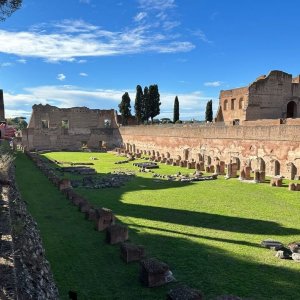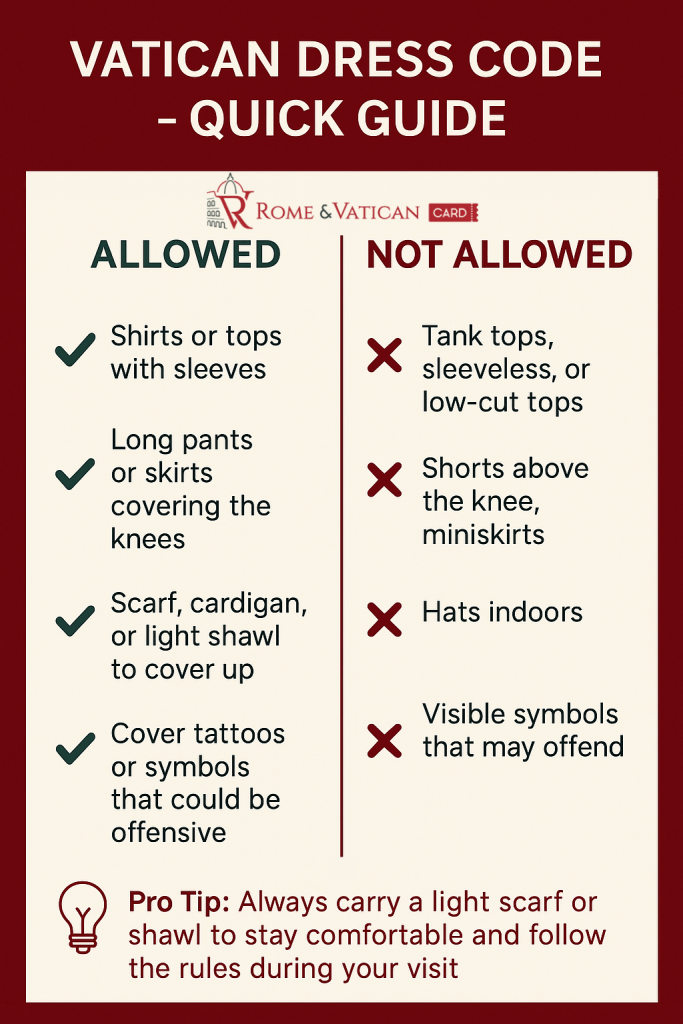Vatican Dress Code: What to Wear in the Vatican Museums
- 14 min read
In this guide you will find all the information about Vatican Dress Code: practical tips on what to wear at the Vatican, including season‑appropriate outfits and stylish yet respectful combinations; essential don’ts to avoid entry issues; and quick fixes if your attire falls short — all to ensure you look and feel appropriate throughout your visit.


First entry Colosseum Guided Tour with Gladiator Arena + Ground and 1st Floor access
See outfit examples and find out what you can and can’t wear when visiting the Vatican, right here: Vatican Dress Code Samples.
From the breathtaking frescoes of the Sistine Chapel to the sacred spaces of the Vatican Museums and the majesty of St. Peter’s Square, your outfit plays a key role in shaping the quality of your visit. The Vatican enforces a dress code meant to reflect the reverence of the place, and knowing what to wear in advance ensures you won’t miss a moment. Here’s everything you need to dress smartly, respectfully, and comfortably.
Is there a Dress Code at the Vatican?
Before packing your bags or stepping into line, it’s important to understand why the Vatican has such strict dress rules.
Why does the Vatican have a dress code?
Vatican City is the heart of the Roman Catholic Church and the smallest sovereign state in the world. It houses some of the most sacred religious sites and invaluable artistic masterpieces. To preserve the spiritual dignity and atmosphere of reverence, a modest dress code is enforced throughout the city-state’s religious and cultural institutions. Whether you’re entering a chapel, walking through museum corridors, Vatican City or attending a papal Mass, the dress code ensures a respectful experience for all visitors.
Is the dress code the same for the Vatican Museums, Vatican City, and the Sistine Chapel?
Yes, the same general standards apply across all religious and cultural sites within Vatican City. Whether you’re walking through the galleries of the Vatican Museums, admiring Michelangelo’s “Last Judgment” in the Sistine Chapel, or exploring the open spaces of St. Peter’s Square, modesty and respect are expected. While areas like the gardens or outdoor courtyards are less formal, entry into any building—including the Museums or the Apostolic Palace — requires adherence to the official dress code.
How strictly is the Vatican dress code enforced?
Quite strictly. Security personnel stationed at entrances conduct visual checks and may deny access to anyone deemed inappropriately dressed. Even small infractions—like bare shoulders or skirts above the knee — can result in being turned away. Signs at every entrance remind visitors of the dress code, and enforcement is consistent throughout the year. It’s always safer to err on the side of formality.
Vatican Dress Code: clothing rules
According to the official Vatican Museums website, sleeveless or low-cut tops, shorts above the knee, miniskirts, or hats are not allowed. This rule applies to all sacred areas of the Vatican, including the Museums, Sistine Chapel, Basilica, and Gardens.
If you’re unsure what to wear, this section provides clear, practical direction on what is—and isn’t—acceptable.
Vatican Dress Code Rules: what you must know
Each visitor must respect these basic rules:
- Shoulders must be covered.
Sleeveless tops, tank tops, halter necks, or strapless dresses are not allowed. Women and men alike must wear shirts or dresses with at least short sleeves. A scarf or shawl can be a good option for quick coverage if needed. - Knees must be covered.
Shorts, skirts, or dresses must fall at least to the knee. Capri pants, maxi skirts, or long dresses are ideal. Garments that ride up while walking or sitting may cause issues at security. - Avoid offensive or provocative designs.
This includes clothing or accessories that display offensive slogans, political messages, or symbols that might be deemed inappropriate in a religious context. Tattoos with explicit or disrespectful imagery should be covered. - Remove hats and caps inside.
Headwear is not permitted inside chapels or museums unless worn for religious or medical reasons. Baseball caps, sun hats, and beanies must be taken off indoors. - No ripped, sheer, or overly casual clothing.
Ripped jeans, transparent garments, athletic wear, or beach attire are considered disrespectful and may lead to denied entry.
Vatican Dress Code for women
Women have many stylish and respectful options that meet Vatican requirements.
Opt for tops with sleeves — short, three-quarter, or long. Dresses and blouses should not be low-cut or sheer. A summer dress with thin straps may be acceptable if worn with a cardigan or light shawl. Skirts and dresses should be at least knee-length. Flowy trousers or culottes made from breathable fabrics like linen or cotton are great for both modesty and comfort. Avoid body-hugging outfits, bold cutouts, or backless designs. Consider flat shoes or sandals with a back strap for all-day walking.
Vatican Dress Code for men
Men are expected to appear clean, neat, and modest.
A polo shirt, button-down shirt, or a plain T-shirt with sleeves is acceptable. Avoid sleeveless tank tops or anything with offensive prints or slogans. Shorts are allowed only if they completely cover the knee; opt for tailored shorts rather than athletic styles. Lightweight trousers or chinos are ideal for summer visits. Sports jerseys, sweatpants, or anything resembling gym attire should be avoided.
Vatican Dress Code for kids
While children are given a bit more flexibility, they must still follow the general dress code.
Young visitors should wear tops that cover their shoulders and bottoms that extend to the knee. Bright colors and kid-friendly designs are fine, but avoid graphic tees with inappropriate language or imagery. Ensure your child removes any hat or cap before entering buildings. Comfortable shoes are a must, especially if you’re doing a long museum tour.

Last entry Colosseum Guided Tour with Gladiator Arena Floor + rooftop aperitif
What to wear in the Vatican: safe choices and practical tips
Dressing for the Vatican requires a balance between comfort, modesty, and style. The right outfit will not only help you respect the sacred atmosphere but also keep you at ease during long hours of exploration through vast museum corridors and religious spaces.
Safe and Stylish Choices
Linen trousers or breathable cotton chinos
These are among the best choices for both men and women. Lightweight and airy, linen or cotton trousers keep you cool during Rome’s hot summer days, while offering full leg coverage in line with Vatican dress rules. They’re also elegant enough for indoor museum settings and practical for long hours of walking.
Midi skirts or A-line dresses
For women, midi-length skirts and A-line dresses are ideal: they are modest, flattering, and comfortable. These styles provide freedom of movement while ensuring that the knees are covered. Pair them with a light wrap or short-sleeved cardigan to easily adapt to both the heat and the indoor dress requirements.
Neutral-toned tops with sleeves
Tops in earthy or muted tones — like beige, taupe, or olive — blend well in the elegant, contemplative environment of the Vatican Museums. Make sure your shirt or blouse has sleeves that at least cover the shoulders. Avoid sheer fabrics or flashy prints, and choose breathable materials to stay comfortable.
Layering pieces: scarves, shawls, light sweaters
Layering is key for a day at the Vatican. A scarf or shawl can be used to cover bare shoulders before entering sacred spaces, while a light sweater offers protection from the often-strong air conditioning inside. These items are easy to fold into your bag and can instantly make your outfit Vatican-appropriate.
Vatican Dress Code for the Seasons: practical tips
No matter the time of year, the Vatican has its own microclimate of sorts—hot outside, cool inside. Planning your outfit with the season in mind helps ensure you remain comfortable and properly dressed at all times.
Summer (June – August):
Expect high temperatures, especially midday. However, inside the Museums and St. Peter’s Basilica, the air conditioning can make it surprisingly chilly. Wear light, breathable clothing that covers shoulders and knees, and always carry a lightweight scarf or pashmina to layer when needed. Choose sandals with a back strap or light closed shoes for walking across stone floors.
Spring/Autumn (March – May, September – October):
These shoulder seasons bring unpredictable weather. You might start the day in sunshine and end it in wind or light rain. Dress in layers, such as a long-sleeved shirt under a light sweater or trench coat, and opt for mid-weight trousers or skirts. These seasons are among the best for visiting the Vatican, as crowds are smaller and temperatures more forgiving.
Winter (November – February):
Winters in Rome can be damp and chilly, especially in the early morning. Wear a wool or fleece sweater under a coat, and bring a scarf for extra warmth and quick compliance with modesty rules. Closed-toe shoes or ankle boots are essential for walking across wet cobblestones or standing in line in cold courtyards.
Examples of “Vatican-friendly outfits”
Need some inspiration? These combinations are practical, stylish, and fully compliant with Vatican standards:
Effortlessly polished:
Picture a white linen button-down shirt, paired with olive-green culottes, ballet flats, and a foldable pashmina tucked into your bag. This look is perfect for museum corridors, garden strolls, or quiet time in the basilica—offering both comfort and elegance without drawing unnecessary attention.
Soft elegance:
Try a navy floral midi dress paired with a beige cardigan and comfortable leather sandals. Complete the look with a neutral tote bag for essentials. This outfit transitions smoothly from daytime sightseeing to evening candlelit chapels and offers just the right amount of refinement for sacred spaces.
Each of these outfits reflects a thoughtful approach to Vatican etiquette: modest, tasteful, and comfortable enough for a full day of cultural immersion.

Colosseum, Roman Forum and Palatine Hill Guided Tour + ancient Rome tour
What NOT to wear in the Vatican
Even one wrong clothing choice can prevent entry into the Vatican’s most iconic spaces. Understanding what not to wear is just as important as knowing what is acceptable.
- Avoid any kind of sleeveless or revealing top, including tank tops, halter necklines, spaghetti straps, or crop tops. While these may be suitable for summer sightseeing elsewhere in Rome, they are not permitted in the Vatican Museums or religious buildings. If you’re wearing such an item, always bring a layer to cover up when entering.
- Shorts or skirts that don’t reach the knee are also forbidden. Even if the difference is just a few centimeters, guards may still deny access. Dresses with slits that rise above the knee can be problematic as well. Always choose a length that you don’t have to constantly adjust while walking or sitting.
- Ripped, distressed, or sheer clothing is another red flag. Even fashionably torn jeans or a top with mesh panels may be interpreted as disrespectful. If you’re unsure whether something is too revealing, the safest route is to leave it behind.
- Athletic wear and beachwear — including beach shorts, sports bras, flip-flops, or tank tops with brand logos — are not allowed. Vatican City is not the place for workout attire.
In short, here’s the what is NOT allowed in the Vatican:
- Sleeveless or low-cut clothing
- Shorts above the knee
- Miniskirts
- Hats indoors
- Visible tattoos or symbols that may be offensive

What to do if you’re NOT dressed correctly
Even the most seasoned travelers can overlook a dress-code detail. If you find yourself underdressed once you’ve arrived, don’t panic — there are easy fixes.
First, approach the security staff and ask politely. In some cases, they may provide disposable cover-ups, like thin shawls or ponchos, especially for shoulder coverage. These are typically available for a small donation or free of charge, depending on the situation.
If you’ve packed smart, use your own cardigan, scarf, or large wrap to cover bare areas. This is the quickest and most convenient solution—many visitors do this at the gate, and it’s perfectly acceptable.
For more serious outfit issues — such as too-short shorts or dresses — you can visit one of the many souvenir vendors just outside the Vatican entrances. Along Via della Conciliazione, dozens of small shops and stalls sell scarves, shawls, lightweight cover-ups, and even Vatican-themed ponchos. Prices range from €5 to €15, and staff are used to tourists needing quick wardrobe fixes.
If all else fails, step out, fix your outfit, and re-enter. Your ticket usually allows for flexible entry within a time slot, and staff are generally accommodating if you return properly dressed within a short timeframe.

Fast first entry Colosseum Guided Tour + Gladiator Arena Floor
Can you buy a cover-up near the Vatican?
Absolutely — and it’s surprisingly easy. The area around St. Peter’s Basilica and the Vatican Museums is filled with shops and stalls catering to visitors who need last-minute clothing fixes.
- Street kiosks: Located along the main roads, these small stands sell everything from postcards to shawls. Their wraps and ponchos are light, colorful, and ideal for quick coverage.
- Souvenir shops: Found along Via della Conciliazione, these stores offer higher-quality scarves and shawls — many with artistic or religious motifs, making them both practical and decorative.
- Pop-up vendors: Especially in peak seasons, local sellers with carts or blankets on the ground offer cheap cover-ups for €5 – €10. They’re not fancy, but they work in a pinch.
No matter where you buy it, having a scarf or shawl in your bag will make your visit smoother and avoid any last-minute stress.
What NOT to bring into the Vatican
Being dressed properly is only part of the preparation. The Vatican also has strict rules about what you can carry inside.
- Avoid large backpacks or bulky bags—they’re often required to be checked at the cloakroom, which can slow down your visit. Instead, bring a compact daypack or crossbody bag.
- Food and beverages are not allowed inside the Museums or Basilica. Eat beforehand and leave any snacks in your bag to avoid issues at security. Glass bottles and alcoholic drinks are strictly forbidden.
- Selfie sticks, tripods, and drones are prohibited inside all Vatican buildings. Flash photography is also banned, especially in the Sistine Chapel, where silence and discretion are paramount.
- Leave expensive jewelry, passports, and large electronics in your hotel safe. Bring only what you need: your ticket, ID, some cash or card, and a lightweight map or guidebook (ideally digital or foldable).
FAQ: Vatican Dress Code
Can I wear sandals to the Vatican?
Yes, as long as they are secure and not beach-style flip-flops. Backstraps or ankle support are preferred. Choose comfort and modesty over style.
Do children have to follow the dress code?
Yes, children are not exempt. While enforcement might be slightly more relaxed, they must still cover shoulders and knees. Playful colors are fine—just avoid offensive prints.
Are ripped jeans or leggings allowed?
No. Even fashionable distressed denim is considered too casual or disrespectful. Leggings worn as pants (without a tunic or long top) are also discouraged.
How strict are the guards?
Very. The Vatican employs a well-trained security team that enforces the dress code without exception. Their goal is not to shame but to preserve the dignity of sacred spaces.
What if I’m coming from a morning tour or hot walk around Rome?
Plan ahead. Even if you’ve been sightseeing all morning, your tourist outfit might not meet the standards. Keep a scarf, extra skirt, or cardigan in your day bag to change quickly before entering.
Don’t Miss This Related Read
“What to Know Before Visiting the Vatican Museums” – Insider tips on skipping lines, timing your visit, and maximising every moment.
👉 A must‑read for anyone planning their perfect Vatican day.
- Check it out now: Vatican Museums Travel Guide
- Want to know what to wear at the Vatican? Check these outfit examples and dress code rules: Vatican Dress Code Samples
- Discover the clothing rules of St Peter’s Basilica here: St Peter’s Basilica Dress Code: what to wear for your Vatican Visit
